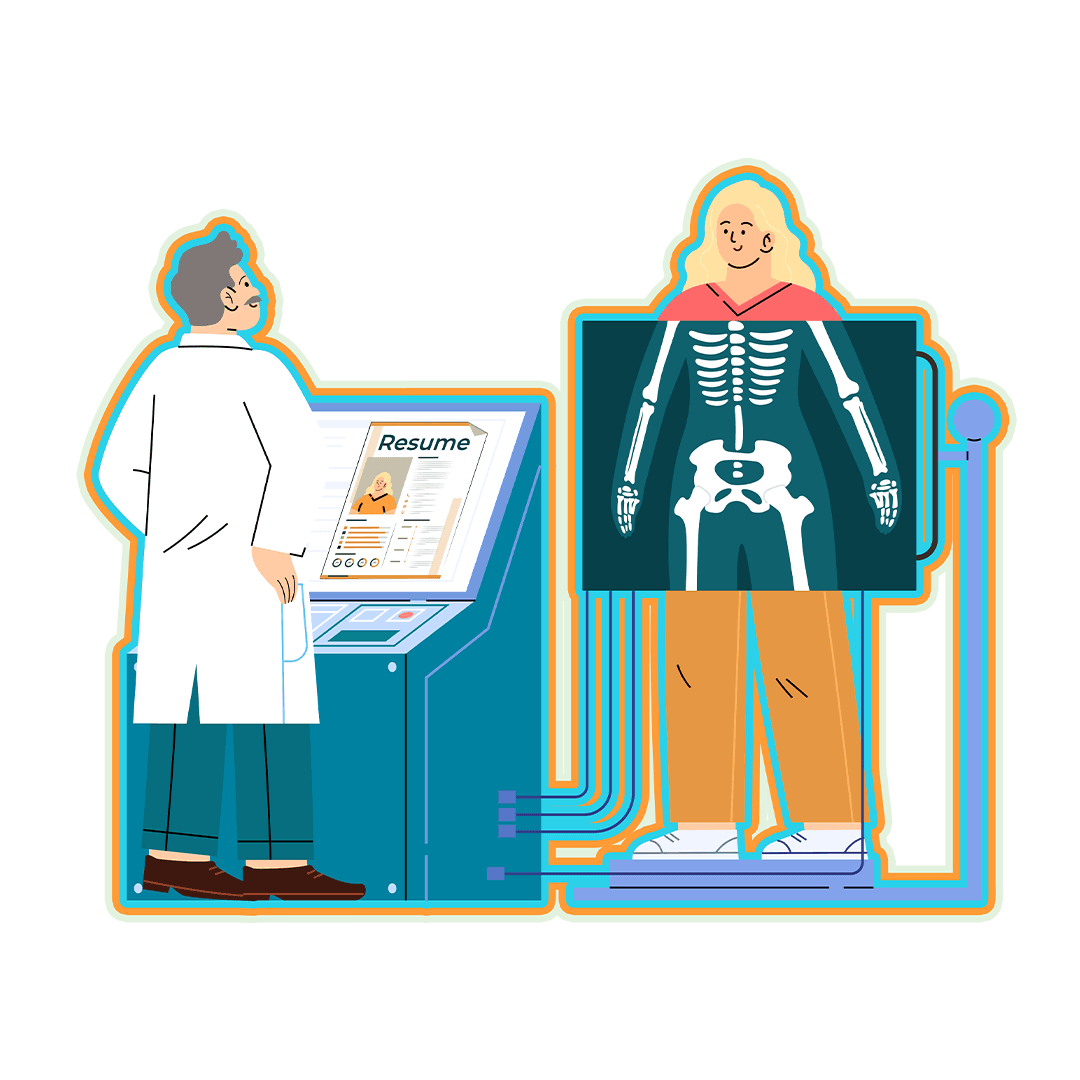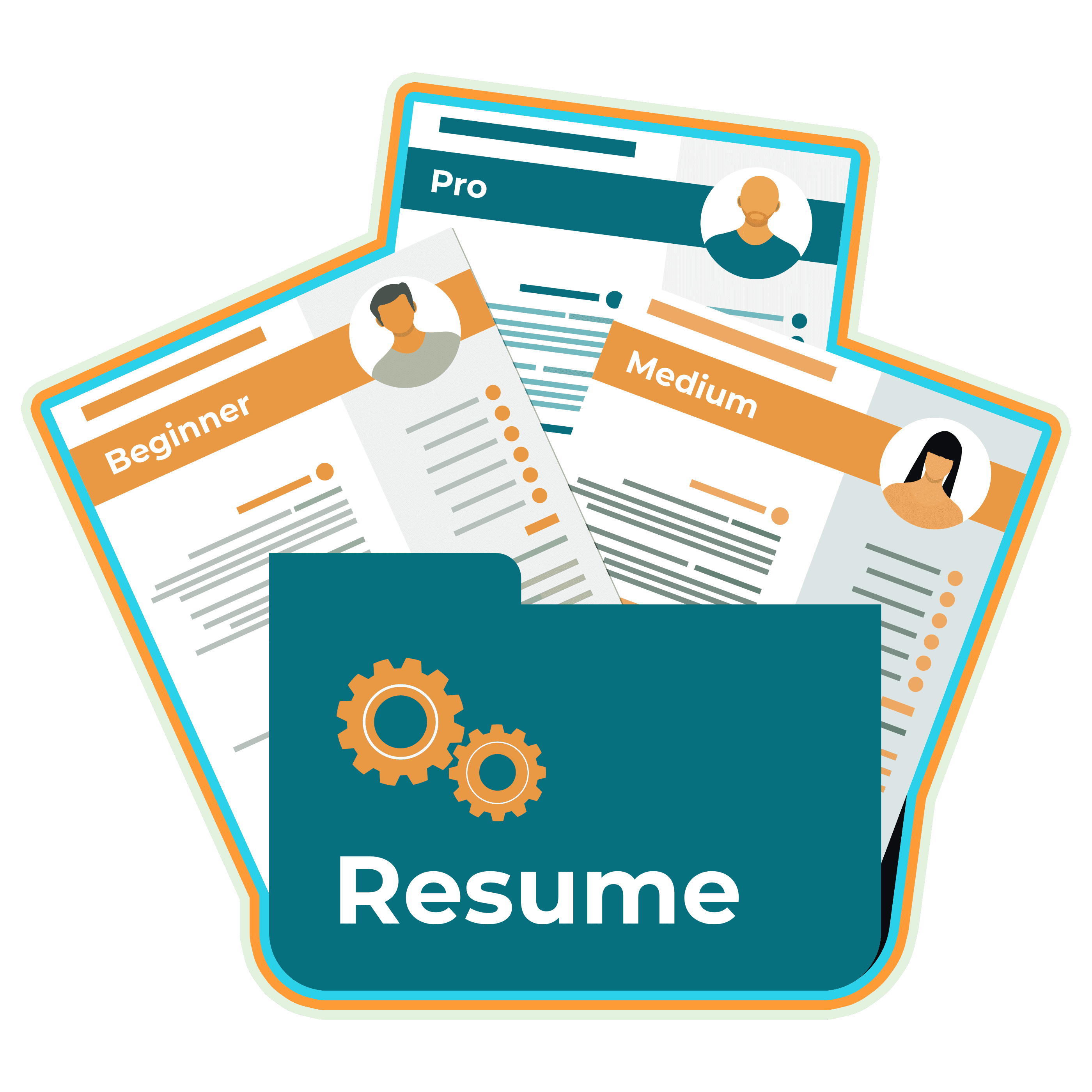Proofreading is the process of carefully reviewing a document to identify and correct spelling, grammar, punctuation, and formatting errors. Proofreading is an essential step in the job application process as it helps to make a positive impression on potential employers.
Proofreading resumes requires careful attention to spelling mistakes, typos, and grammatical errors. Take the time to check for common errors and homophones, and don't solely rely on automated spell-check tools. Pay attention to the formatting and layout of the resume. Ensure that font sizes and bullet points are used consistently throughout the document. Align headings, dates, and job titles properly to maintain a professional appearance. Verify the accuracy of all information provided in the resume, including dates, job titles, company names, and contact details.
Proofreading a resume is essential to ensure accuracy, professionalism, and a solid first impression on potential employers. There are the top ten tips for proofreading a resume and ensuring it's error-free. Listed below are five additional tips for proofreading a resume.
A proofreader reviews the document to identify and correct any errors or inconsistencies, ensuring it presents a polished and professional image to potential employers. A proofreader resume thoroughly checks for spelling, grammar, and punctuation errors while ensuring consistent formatting and proper use of capitalization, abbreviations, and acronyms. A proofreader provides valuable feedback and suggestions to enhance the quality and impact of the resume.
Contact professionals such as career coaches, resume writers, human resources professionals, grammar experts, executive leaders, alumni centers, and local career centers for a resume review. It is not recommended to seek reviews from friends or family members and recruiters, as these people lack expertise in resume writing or hiring practices. There are tips on how to ask someone to review a resume, including asking specific questions about initial impressions, areas for improvement, and the type of position the resume appears to target.
Seeking multiple opinions from different reviewers helps identify common areas for enhancement while acknowledging the need to select strategies that work best for individual circumstances.
What Is Proofreading?
Proofreading is the process of carefully reviewing a document to identify and correct spelling, grammar, punctuation, and formatting errors. Resume proofreading involves meticulously inspecting a resume for accuracy, clarity, and professionalism. A resume proofreading service specializes in reviewing and improving resumes, offering expert assistance to individuals seeking to optimize their resumes for job applications.
Proofreading is a crucial step in the resume writing process. The process goes beyond spell-checking to ensure the quality of a document as a whole. Resume proofreading services are valuable resources for individuals who want to enhance the effectiveness of their resumes. Resume proofreading services employ skilled proofreaders with a keen eye for detail and a deep understanding of industry standards.
An online resume proofreading service thoroughly examines the content for spelling, grammar, and punctuation mistakes. Proofreaders focus on refining the formatting and layout of the resume to ensure consistency and readability. The process involves checking for consistent use of fonts, font sizes, margins, and alignment of headings and bullet points.
Proofreading pays attention to the overall structure and organization of the resume. They analyze the flow of information, ensuring it is logical and coherent.
What Should You Proofread In A Resume Before Sending The File?
To proofread a resume to ensure a polished and error-free document before sending it. Pay attention to spelling and grammar, check for formatting and layout consistency, and verify the information's accuracy. Focusing on spelling, grammar, formatting, layout consistency, and information accuracy increases the professionalism and effectiveness of the resume. The following items are essential to be considered while a resume proofreading and editing.
- Spelling and grammar: Check for spelling, typos, and grammatical mistakes throughout the document. Pay attention to commonly misspelled words and ensure proper grammar usage.
- Formatting and layout: Ensure consistent formatting and a professional layout. Check for constant use of fonts, font sizes, and bullet points. Ensure that headings, dates, and job titles are appropriately aligned. Pay attention to spacing, margins, and overall visual appeal.
- Content accuracy: Verify the accuracy of all the information provided in the resume. Double-check dates, job titles, company names, and contact details to ensure they are correct. Cross-reference the information with other documents or references, such as cover letters or application forms.
- Consistency: Maintain consistency throughout the resume. Ensure that formatting, style, and punctuation are consistent across sections. Use consistent verb tenses and capitalization. Check for consistent use of abbreviations, acronyms, and terminology.
- Readability and clarity: Review the resume for readability and clarity. Ensure that sentences and phrases are clear and easy to understand. Avoid excessive jargon or technical terms that might confuse the reader. Consider the overall flow and organization of the content to ensure it is logical and coherent.
- Contact information: Double-check contact information, including phone number, email address, and LinkedIn profile. Make sure contact information is accurate and up to date.
- Tailoring: Ensure that the resume is customized to suit the requirements of the specific job or industry being targeted. Customize it to highlight relevant skills, experiences, and achievements that align with the desired position.
Why Should You Proofread Your Resume?
Proofreading your resume is essential to ensure accuracy, professionalism, and a solid first impression on potential employers. Proofreading is crucial because even minor errors or inconsistencies in a resume undermine the candidate’s credibility and professionalism. Employers often receive numerous applications, and a resume with spelling mistakes, grammatical errors, or formatting issues quickly be dismissed. Attention to detail, strong communication skills, and a commitment to presenting oneself in the best conceivable light are demonstrated by thoroughly proofreading a resume.
Proofreading allows for correcting any factual inaccuracies or outdated information. It ensures that contact details, job titles, dates, and other relevant information are correct and consistent. Providing accurate and up-to-date information is crucial for employers to contact the candidate and verify background.
Proofreading enhances the overall readability and clarity of the resume. Proofreading and editing a resume reviews the structure and flow of the content, ensuring that it is well-organized, logical, and effectively showcases skills and experiences. A well-proofread resume presents information concisely and engagingly, making it easier for employers to understand qualifications and suitability for the position.
How Do You Proofread A Resume?
Here are the top ten editing and proofreading resume tips and ensuring it's error-free.
1. Review the resume slowly.
Reading often involves absorbing large chunks of information simultaneously. To effectively proofread it, it is crucial to read it slowly, focusing on each word and punctuation mark. Reviewing a resume slowly allows for meticulously examining the content, ensuring accuracy, and identifying errors or inconsistencies.
2. Utilize editing tools.
Use automated tools like spellcheck and Grammarly to identify potential errors and suggest improvements. Remember that spellcheck and grammar check tools are not infallible, so it is essential to carefully review their suggestions before accepting them.
3. Remove repeated words.
Eliminate unnecessary repetition of words throughout the resume. Check for instances where the same word or phrase is used multiple times and find alternative ways to express the same idea. Eliminating helps to enhance the clarity and conciseness of the document.
4. Avoid clichés.
Steer clear of overused and clichéd phrases commonly found in resumes. Examples such as "self-starter," "team player," "results-oriented," "strong communication skills,” and "thinking outside the box" are clichéd phrases that have become worn-out in resumes. Strive for originality and use language that reflects unique qualities and experiences. Stand out from the crowd by employing new and engaging wording.
5. Ensure all necessary information is included.
Refer to a comprehensive resume guide to ensure that all essential elements are present in a resume, such as contact information, summary/profile, employment history, education, and skills sections. Double-check for any crucial details that might be missing from the document.
6. Read the resume aloud.
Engage a sense of hearing by reading the resume aloud. The reading-aloud technique helps identify repeated words and assess the content's overall flow. Reading the resume aloud allows for a more thorough evaluation of sentence transitions and ensures coherence in writing.
7. Avoid catching everything at once.
Focus on specific types of errors during each round of proofreading. For instance, dedicate the first round to spotting spelling mistakes, the second round to ensuring verb tense consistency, the third round to identifying the use of passive voice, and the fourth round to checking font sizes and spacing.
8. Print out the resume and review it again.
Printing the resume provides a different visual format that helps identify errors or inconsistencies that not be as noticeable on a computer screen. Reading a hard copy brings attention to details that might have been overlooked.
9. Check for formatting problems.
Pay attention to formatting issues such as font selection, size, margins, spacing, and overall design. Use a professionally designed resume template to ensure a visually appealing and well-presented document.
10. Seek the help of an editor.
Consider having an experienced editor, English teacher, or professional writer review a resume. An outside perspective provides valuable insights, identifies any writing problems, and offers suggestions for improvement.
Proofreading Tips That Will Improve Your Resume
Listed below are five additional tips for proofreading a resume.
- Create a proofreading checklist: Review the following examples to ensure all important aspects are noticed.
- Spelling errors
- Punctuation mistakes
- Grammatical mistakes
- Consistency of fonts, bullets, etc.
- Accuracy of dates, contact information, abbreviations, and spacing
- Verification of links, such as the LinkedIn profile, emails, and other contact details
- Read the content aloud and in reverse order: Reading content aloud aids in identifying errors by hearing the words during the reading process. Reading aloud provides insight into how recruiters will perceive the resume. Reading from the bottom up is an effective method for catching spelling and capitalization errors, as it compels the brain to slow down and focus on each word individually.
- Seek the assistance of another person: Having a fresh perspective is highly beneficial, as other people easily spot errors that the writer has overlooked.
- Customize for each application: A resume is required to be tailored to match the specific requirements and keywords mentioned in the job description. Customizing a resume demonstrates genuine interest and alignment with the position, increasing the chances of being noticed by recruiters.
- Utilize professional proofreading services: Services like Career Expert offer resume reviews and objective feedback. Engaging the services of a professional resume writer is worthwhile if writing or crafting an effective resume is challenging.
What Does A Proofreader Do For A Resume?
A proofreader reviews the document to identify and correct any errors or inconsistencies, ensuring it presents a polished and professional image to potential employers. Below are vital responsibilities a proofreader does an eye for detail proofreading a resume.
- Checks for spelling, grammar, and punctuation errors
- Verifies the consistency of formatting, font usage, and bullet points
- Ensures proper and consistent use of capitalization, abbreviations, and acronyms
- Reviews the overall flow and coherence of the content
- Edits for clarity, conciseness, and effective communication of skills and achievements
- Provides valuable feedback and suggestions for improvement
Career Expert offers professional proofreading services to help individuals create compelling and error-free resumes that stand out in the competitive job market. Our experienced proofreaders meticulously review resumes, ensuring they are polished and optimized for maximum impact.
People, you should ask to review your resume.
The most valuable review is gained by reaching out to individuals with the expertise and insight to provide valuable input and proofreading experience in a resume. Consider reaching out to the following seven choices for quick resume proofreading.
- Career Coach: Career coaches guide optimizing resumes for applicant tracking systems. They offer advice on eliminating unnecessary content and transforming job duties into impactful accomplishments.
- Resume Writer or Proofreader: A resume writer is well-versed in current resume trends, but their focus is primarily on enhancing the document rather than providing extensive coaching. A resume writer is suitable if someone is confident in their career path and seeks professional input on improving the impact of their resume.
- Human Resources Professionals: A human resources professional, such as a hiring manager, has extensive knowledge of the hiring process to help ensure the resume meets the expectations and preferences of potential employers.
- An Expert in Grammar: Someone proficient in grammar who works as a copy editor or a friend known for consistently correcting grammar in various contexts, including texts and social media posts. It is essential to seek someone who understands the candidate's abilities and effectively identifies any inadvertent typos or misplaced punctuation. A person proficient in grammar provides personalized feedback while addressing meticulous technical edits.
- Executive Leaders: The individuals holding hiring positions at various institutions possess valuable expertise in their respective functional areas within student affairs. Their responsibilities encompass reviewing resumes for available jobs and ultimately making informed hiring decisions. Regardless of the workplace, seeking their advice yields valuable insights and guidance.
- Alumni Center: Many college alumni associations offer resume workshops and review services to their members. Alumni Center services are often free, though joining the alumni association requires a fee sometimes. Alumni centers usually have connections to individuals or resources that offer assistance even if they don't directly provide resume reviews.
- Local Career Center: Various states and cities provide job search resources, including resume review services. Resume review services offer less personalization or promptness than other options but are typically free, making them an excellent resource.
People you shouldn't ask to review your resume.
There are two distinct groups of individuals from whom seeking a resume review is not beneficial in most cases. This is not because they might offer unfavorable feedback but rather due to their limited ability to assist in achieving objectives. Some people lack the knowledge or understanding of resume best practices and industry standards. Their lack of resume writing expertise or hiring practices results in inaccurate or outdated advice. Below are two types of individuals to avoid approaching resume reviews.
- Friends or family members
- Recruiters
How To Ask Someone To Review Your Resume
To ask someone to review a resume, write an e-mail and ask questions. The success of a resume depends significantly on the quality of the questions posed to the resume reviewer. Below are the essential inquiries to ask the resume reviewers once submitted all materials.
- What are your initial impressions after quickly reviewing my resume for 10 seconds?
- Which aspects of my resume stand out to you the most and leave a positive impression?
- What areas of my resume do you think could be improved or enhanced?
Having received valuable feedback from the resume reviewer, it's time to dig deeper into inquiries. The following questions help improve a resume by editing and proofreading a resume.
- What type of position does it appear that I'm applying for based on my resume?
- At what point did you start skimming or quickly scanning my resume?
- Do you have any specific questions after reading my resume?
Once receiving feedback on a resume, it's time to seek well-deserved input. Below are the top three areas where a reviewer offers the most valuable and focused feedback.
- Reviewing grammar and spelling to ensure accuracy
- Determining what are included on the resume and what are excluded
- Advising on key elements to emphasize to make the resume stand out to hiring managers
How to add proofreading to a resume? One of the challenges when asking for resume reviews is that different individuals provide contradictory advice and feedback. It's important to note that proofreading requires one to reflect on the shortcomings. It is reasonable to receive ten divergent opinions when seeking input from ten people.
The best approach is to consider making changes if most people suggest the same modification. Decide whether to accept or disregard changes if only a few individuals recommend a change.
Conclusion
Proofreading a resume involves reviewing and correcting errors, inconsistencies, and formatting issues to ensure the document is accurate, professional, and well-presented. Seeking feedback on a resume significantly enhances its quality and effectiveness. Engaging with reviewers who possess expertise in the field allows candidates to receive valuable insights and guidance. Remember to consider various aspects, such as grammar and spelling, resume content selection, and highlighting key strengths to capture the attention of hiring managers.
It is important to acknowledge that feedback varies from person to person, and this diversity of opinions is not perceived as a reflection of abilities. Focus on identifying common recommendations from multiple reviewers, which often hold merit.
Remember that the ultimate goal is to tailor a resume to align with career objectives and make it stand out among other applicants. Embrace the strategies that resonate and discard those that do not align with goals and preferences. It is attainable to continually refine and strengthen a resume by embracing constructive feedback and applying the most relevant advice.




